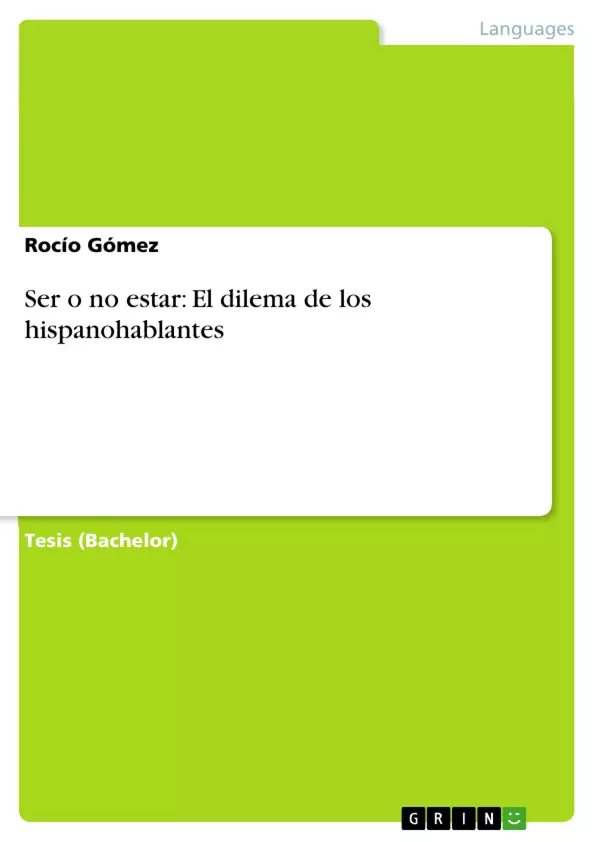The purpose of this thesis is to discover whether the dichotomy of Ser/Estar in Spanish, in contrast with the verb To Be in English, represents not only a different view of the world of their speakers, but also a difficulty in the translation of said verbs. In order to find an answer, this work was divided in different sections for a more comprehensive analysis of all its variables.
First of all, a section regarding the history of the copulas and the languages in question was provided, in order to identify their origins, development throughout time, among other factors. The aim of this analysis was to discover why both languages differed in their copulas, given that it would seem English speakers never found themselves in the need to make a distinction so obvious in Spanish. The following step was an overview of the philosophical value of ser, as explained by many well-known thinkers of all periods. The purpose of the overview was to further comprehend a very important difference between ser and estar, as well as to compare them with their English equivalent. Another subject studied in this section was the importance of language in the construction of reality. This was also important due to the fact that, throughout history, the views regarding the world, the society and people themselves have changed progressively; and said evolution, in turn, affected and was affected by the language.
After setting forth these baselines, texts from different periods, both in English and Spanish were analyzed. This served to examine the evolution of the uses and spelling of the three verbs during the different times in history, and corroborate and expand the results found in the first stage of this work. Within this section there was also an analysis of difficult cases regarding the translation of these verbs, taking different popular examples, among which was the famous soliloquy To be or not to be. The results obtained provided a framework to find methods to facilitate the translation of ser, estar and to be, both from Spanish into English – which was particularly problematic – and vice versa.
It was concluded that even if there were not two separate words in English to represent both Spanish copulas, the language had evolved to provide different resources to make the differences clearer; resources which could be of much use in the translation of problematic cases.
Inhaltsverzeichnis
- Agradecimientos
- Abstract
- 1. Introducción
- 2. Ser y estar en contexto
- 2.A Consideraciones iniciales
- 2.B Etimologías
- 2.C Breve recorrido por los inicios y el desarrollo del español
- 2.D Breve recorrido por los inicios y el desarrollo del inglés
- 2.E El ser como concepto filosófico
- 2.F El papel del lenguaje en la construcción de la realidad
- 3. Las huellas literarias de los verbos copulativos
- 3.A Sobre la Evolución de los verbos ser, estar y to be
- 3.Aa To be
- 3.Ab Ser y estar
- 3.B Sobre la traducción de los verbos ser, estar y to be
- 4. Conclusión
- Bibliografía
Zielsetzung und Themenschwerpunkte
El objetivo principal de esta tesina es analizar la dicotomía entre los verbos "ser" y "estar" en español, en contraste con el verbo "to be" en inglés, para determinar si esta diferencia representa no solo una visión del mundo distinta entre los hablantes de ambas lenguas, sino también una dificultad en la traducción de estos verbos. Para alcanzar este objetivo, la tesina se estructura en secciones que permiten un análisis exhaustivo de las variables involucradas.
- El desarrollo histórico de las cópulas y las lenguas en cuestión, incluyendo su origen, evolución a lo largo del tiempo y otros factores relevantes.
- El valor filosófico del verbo "ser" como se expone en las ideas de diversos pensadores a través de la historia.
- El papel del lenguaje en la construcción de la realidad, tomando en cuenta la evolución de la sociedad, las perspectivas del mundo y los individuos.
- El análisis de textos literarios en inglés y español de diferentes épocas, para examinar la evolución de los usos y la ortografía de los tres verbos.
- El análisis de casos complejos relacionados con la traducción de estos verbos, incluyendo ejemplos populares como el famoso soliloquio "To be or not to be".
Zusammenfassung der Kapitel
El primer capítulo presenta una introducción al tema, contextualizando la dicotomía entre "ser" y "estar" en español y "to be" en inglés.
El segundo capítulo explora el contexto de "ser" y "estar" en español. Se analizan las consideraciones iniciales, las etimologías, la historia del desarrollo del español y del inglés, la concepción filosófica del "ser" y el rol del lenguaje en la construcción de la realidad.
El tercer capítulo examina las huellas literarias de los verbos copulativos, analizando la evolución de los verbos "ser", "estar" y "to be" a través del tiempo, incluyendo ejemplos de su uso en textos literarios.
Schlüsselwörter
Los términos clave que se exploran en esta tesina son: ser, estar, to be, valor filosófico del ser, construcción de la realidad, análisis socio-histórico de las cópulas y traducción de las cópulas.
- Citar trabajo
- Rocío Gómez (Autor), 2014, Ser o no estar: El dilema de los hispanohablantes, Múnich, GRIN Verlag, https://www.grin.com/document/288771



